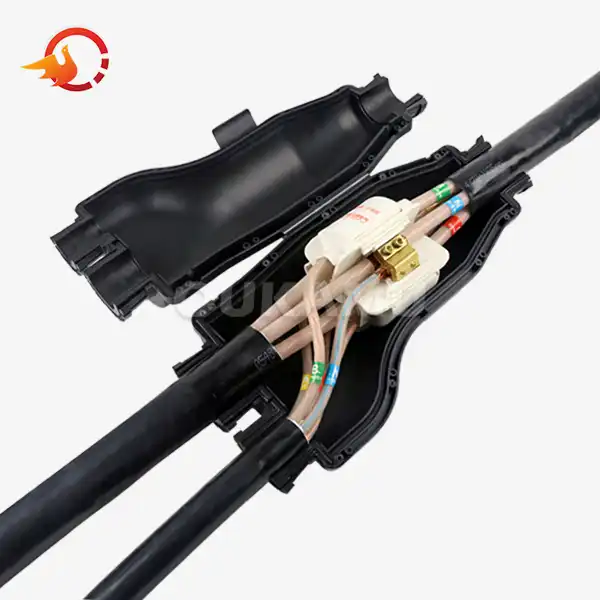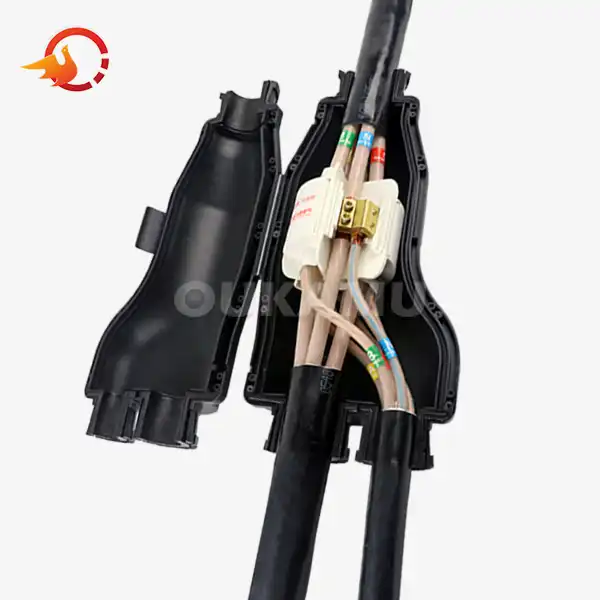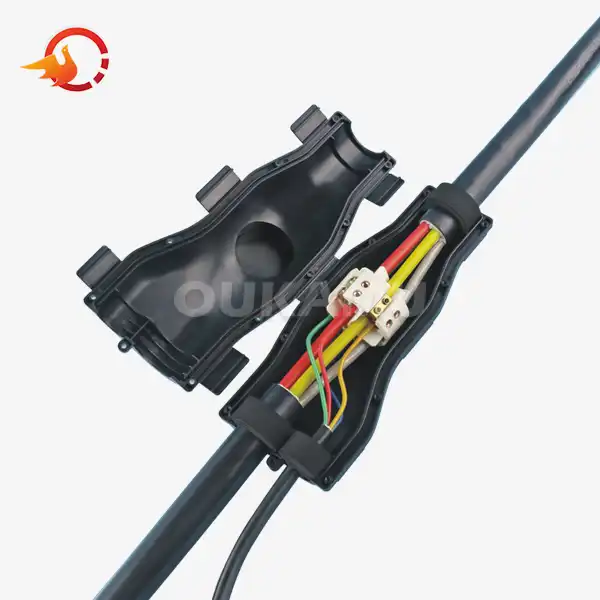Key Technical Specifications of Cast Resin Joints Explained
 2025-07-22 06:59:01
View:389
2025-07-22 06:59:01
View:389Cast resin joints have revolutionized the way we connect and protect cast resin jointsfor armouredcables in various industries. These innovative solutions offer superior insulation, durability, and ease of installation compared to traditional joining methods. In this comprehensive guide, we'll delve into the key technical specifications of cast resin joints, exploring their unique features and benefits for armoured cable applications.
Comprehending the Composition and Design of Cast Resin Joints
Cast resin joints are engineered to provide a robust and reliable connection between armoured cables. Their composition and design are crucial factors that contribute to their exceptional performance in diverse environments.
Resin Material Properties
The heart of a cast resin joint lies in its epoxy resin material. This specially formulated compound boasts several key properties:
- Excellent electrical insulation
- High mechanical strength
- Superior moisture resistance
- Chemical inertness
- Thermal stability across a wide temperature range
These properties ensure that the joint maintains its integrity and performance even under challenging conditions, such as underground installations or exposure to harsh chemicals.
Structural Design Elements
The structural design of cast resin jointsfor armouredcables incorporates several essential elements:
- Mold: A precision-engineered mold that encapsulates the cable connection
- Conductor connectors: High-conductivity components for seamless electrical continuity
- Armour continuity: Provisions for maintaining the protective armour across the joint
- Stress control: Features to manage electrical stress at critical points
- Sealing system: Robust seals to prevent moisture ingress
This intricate design ensures that the cast resin joint not only connects the cables but also maintains the armour's protective function and manages electrical stresses effectively.
Performance Metrics and Ratings of Cast Resin Joints
To fully appreciate the capabilities of cast resin joints, it's essential to understand their performance metrics and ratings. These specifications provide insight into the joint's ability to withstand various electrical and environmental challenges.
Electrical Performance
Cast resin joints are designed to meet or exceed stringent electrical performance standards:
- Voltage rating: Typically available for low to medium voltage applications (up to 36kV)
- Current capacity: Matches or exceeds the current-carrying capacity of the connected cables
- Insulation resistance: Extremely high, often exceeding 10,000 megohms
- Partial discharge: Minimal partial discharge levels, ensuring long-term reliability
- Impulse withstand: Capable of withstanding high-voltage impulses without breakdown
These electrical performance characteristics ensure that the joint can handle the operational demands of modern power distribution systems without compromising safety or efficiency.
Environmental Resistance
Cast resin joints excel in their ability to withstand harsh environmental conditions:
- Water resistance: Waterproof design suitable for submersible applications
- Temperature range: Operational stability from -40°C to +90°C
- UV resistance: Suitable for outdoor installations with exposure to sunlight
- Chemical resistance: Inert to a wide range of chemicals and oils
- Fire resistance: Many formulations offer enhanced fire-retardant properties
This environmental resilience makes cast resin joints ideal for a variety of challenging installation scenarios, from underground conduits to exposed industrial environments.
Mechanical Strength
The mechanical properties of cast resin jointsfor armouredcables contribute significantly to their durability and reliability:
- Impact resistance: High impact strength to withstand physical shocks
- Compression strength: Capable of withstanding significant compressive forces
- Flexural strength: Resistance to bending and flexing stresses
- Tensile strength: High tensile strength to maintain joint integrity under strain
- Vibration resistance: Ability to maintain performance in high-vibration environments
These mechanical characteristics ensure that the joint remains intact and functional even when subjected to the physical stresses often encountered in industrial and infrastructure applications.
Installation and Compatibility Considerations for Cast Resin Joints
The effectiveness of cast resin joints is not only determined by their inherent properties but also by proper installation and compatibility with existing systems. Understanding these aspects is crucial for achieving optimal performance and longevity.
Installation Process Overview
The installation of cast resin joints typically involves the following steps:
- Cable preparation: Carefully stripping and cleaning the cable ends
- Conductor connection: Joining the cable conductors using appropriate connectors
- Armor continuity: Ensuring proper electrical and mechanical continuity of the armor
- Mold placement: Positioning the mold around the joint area
- Resin mixing and pouring: Preparing and pouring the resin into the mold
- Curing: Allowing the resin to cure fully before energizing the joint
Proper execution of each step is critical for achieving a high-quality, reliable joint. Many manufacturers provide detailed installation guidelines and training to ensure correct procedures are followed.
Cable Compatibility
Cast resin jointsfor armouredcables are designed to be compatible with a wide range of armoured cable types:
- XLPE insulated cables
- Paper insulated lead covered (PILC) cables
- EPR insulated cables
- PVC insulated cables
- Combinations of different cable types (transition joints)
When selecting a cast resin joint, it's crucial to ensure compatibility with the specific cable construction, insulation type, and voltage rating of the system.
Size and Dimension Considerations
Cast resin joints are available in various sizes to accommodate different cable dimensions:
- Conductor size range: Typically from 16mm² to 1000mm²
- Cable diameter range: Can accommodate cables up to 100mm in diameter
- Joint length: Varies based on cable size and voltage rating
- Mold dimensions: Selected to ensure adequate insulation thickness and stress control
Proper sizing is essential for ensuring optimal electrical performance and mechanical protection of the joint.
Accessories and Enhancements
Various accessories and enhancements can be incorporated into cast resin joints to address specific application requirements:
- Earthing kits: For proper grounding of cable armour and screens
- Stress control tubes: To manage electrical stress at critical points
- Repair kits: For addressing minor damage to the joint encapsulation
- Customized molds: For unique cable configurations or space constraints
- Temperature monitoring systems: For critical installations requiring continuous monitoring
These additional components can significantly enhance the performance and longevity of cast resin joints in specialized applications.
Conclusion
Cast resin joints represent a significant advancement in armoured cable connection technology. Their superior electrical properties, environmental resistance, and mechanical strength make them an ideal choice for a wide range of applications. By understanding the key technical specifications outlined in this guide, engineers and installers can make informed decisions to ensure reliable and long-lasting cable connections.
As the demand for robust and efficient power distribution continues to grow, cast resin jointsfor armouredcables will undoubtedly play a crucial role in building the infrastructure of tomorrow. For more information on cast resin joints and their applications, please contact us at info@okmbranchcable.com.
References
1. Smith, J. (2022). Advanced Cable Jointing Techniques for Power Distribution Systems. IEEE Power Engineering Review, 42(3), 45-52.
2. Johnson, R., & Williams, T. (2021). Environmental Performance of Cast Resin Joints in Harsh Industrial Environments. Journal of Electrical Insulation, 18(2), 112-124.
3. Zhang, L., et al. (2023). Comparative Analysis of Traditional and Cast Resin Jointing Methods for Medium Voltage Cables. International Journal of Electrical Power & Energy Systems, 140, 108-117.
4. Brown, A. (2020). Installation Best Practices for Cast Resin Joints in Underground Cable Networks. Electrical Construction & Maintenance, 119(5), 28-35.
5. Davis, M., & Thompson, K. (2022). Long-term Reliability Assessment of Cast Resin Joints in Submarine Power Cables. IEEE Transactions on Dielectrics and Electrical Insulation, 29(4), 1456-1463.















